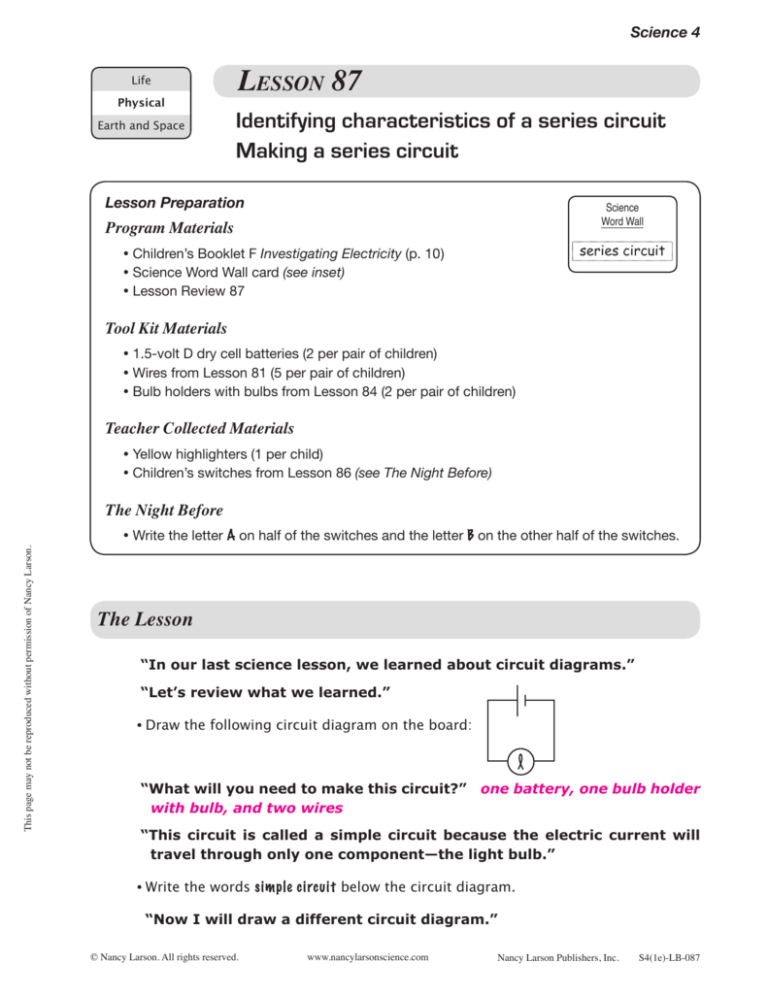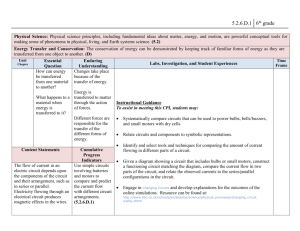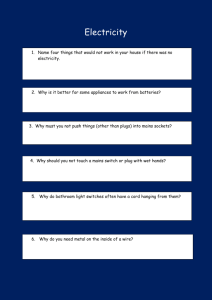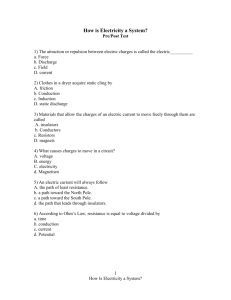
Science 4
Life
Physical
Earth and Space
LESSON 87
Identifying characteristics of a series circuit
Making a series circuit
Lesson Preparation
Science
Word Wall
Program Materials
series circuit
ü Children’s Booklet F Investigating Electricity (p. 10 )
ü Science Word Wall card (see inset)
ü Lesson Review 87
Tool Kit Materials
ü 1.5-volt D dry cell batteries (2 per pair of children)
ü Wires from Lesson 81 (5 per pair of children)
ü Bulb holders with bulbs from Lesson 84 (2 per pair of children)
Teacher Collected Materials
ü Yellow highlighters (1 per child)
ü Children’s switches from Lesson 86 (see The Night Before)
The Night Before
This page may not be reproduced without permission of Nancy Larson.
ü Write the letter A on half of the switches and the letter B on the other half of the switches.
The Lesson
“In our last science lesson, we learned about circuit diagrams.”
“Let’s review what we learned.”
• Draw the following circuit diagram on the board:
“What will you need to make this circuit?”
with bulb, and two wires
one battery, one bulb holder
“This circuit is called a simple circuit because the electric current will
travel through only one component—the light bulb.”
• Write the words simple circui t below the circuit diagram.
“Now I will draw a different circuit diagram.”
© Nancy Larson. All rights reserved.
www.nancylarsonscience.com
Nancy Larson Publishers, Inc.
S4(1e)-LB-087
Science 4, Lesson 87
• Draw the following circuit diagram on the board next to the first circuit diagram:
“How is this circuit different from the first circuit I drew?”
two bulb holders with bulbs instead of one.
“What components will you need to make this circuit?”
two bulb holders with bulbs, and three wires
There are
one battery,
“This is called a series circuit because there are two light bulbs in the
circuit, and the electric current will travel through both of the light
bulbs, one after another, along one continuous path.”
• Write the words se r ie s circui t below the circuit diagram.
“Now you will work with a partner to make these circuits.”
“First you will make the simple circuit.”
• Pair children.
• Distribute a battery, bulb holder with bulb, and two wires to each pair of children.
“Work with your partner to make the simple circuit shown on the
board.”
• The circuit should look like the
circuit shown in this photo.
“What will I need to give you so you can make the series circuit?” one
more bulb holder with bulb and one more wire
• Distribute another bulb holder with bulb and wire to each pair of children.
“Work with your partner to make the series circuit shown on the
board.”
• Circulate and assist children as they make the series circuit.
2
© Nancy Larson. All rights reserved.
This page may not be reproduced without permission of Nancy Larson.
• Circulate and assist children as they make the simple circuit.
Science 4, Lesson 87
• The circuit should look like the
circuit shown in this photo.
“What do you notice about the brightness of the bulbs in the series circuit
compared with the brightness of the bulb in the simple circuit?” The
bulbs in the series circuit are not as bright.
“The bulbs in the series circuit are not as bright because the two bulbs
are sharing the 1.5 volts of power from the battery.”
“What could we do to make the bulbs brighter?”
• Allow time for the children to offer suggestions.
“Let’s observe what happens when there are two batteries in the series
circuit instead of one.”
• Distribute another battery to each pair of children.
“Work with your partner to make a series circuit with two batteries.”
This page may not be reproduced without permission of Nancy Larson.
• Circulate and assist children as they make the series circuit with two batteries.
• The circuit should look like the
circuit shown in this photo.
“What do you notice about the bulbs when two dry cell batteries are
used in a series circuit instead of one?” The light from the bulbs is
brighter.
“What do you think will happen if I remove one of the bulbs in a series
circuit?”
“Watch what happens.”
• Unscrew and remove one of the bulbs in one of the children’s circuits.
“What happened?”
© Nancy Larson. All rights reserved.
The other bulb in the circuit is not lit.
3
Science 4, Lesson 87
• Replace the bulb in the bulb holder.
• Unscrew and remove the other bulb.
“What happened?”
The other bulb in the circuit is not lit.
“When one bulb in a series circuit is removed, the circuit is opened and
the other bulb will not light.”
• Replace the bulb in the bulb holder.
“Let’s read about series circuits.”
“Put the batteries, wires, and bulb holders with bulbs on the upper corner
of your desk.”
“Take out your electricity booklet and highlighter.”
“Turn to page 10 in your booklet.”
“What is the title of this page?” Series Circuit
“Follow along as I read paragraph 1.”
• Read paragraph 1 as the children follow along.
In a series circuit, the electric current passes through two or more
components, one after another, along one continuous path. If one component
is disconnected or broken, the circuit is opened and the electric current does
not flow. In a string of lights connected in a series, when one bulb is broken or
missing, none of the bulbs will light.
“In the first sentence, highlight the words ‘series circuit’ and ‘one
continuous path.’ ”
“What will cause a series circuit to be open?”
disconnected or broken.
One component is
“Look at the diagram of the series circuit in the middle of the page.”
“How many dry cell batteries will you need to make this circuit?” two
“How many bulb holders with bulbs will you need?”
“What else will you need?”
two
two switches and five wires
“I will give you two switches and two more wires.”
“Work with your partner to make the series circuit shown in your
booklet.”
4
© Nancy Larson. All rights reserved.
This page may not be reproduced without permission of Nancy Larson.
“What happens in a series circuit?” The electric current passes through
two or more components, one after another, along one continuous
path.
Science 4, Lesson 87
• Distribute two switches, one with the letter “A” and the other with the letter “B,” and
two additional wires to each pair of children.
• Circulate and assist children as they make a series circuit to match the circuit
diagram.
“Close both switches.”
“What happened?”
The bulbs lit.
“Open one of the switches.”
“What happened?”
Both bulbs did not light.
“Close the switch that is open and open the other switch.”
“What happened?”
Both bulbs did not light.
“Open both switches.”
“What happened?”
Both bulbs did not light.
“Now you will work with your partner to complete the chart at the bottom
of page 10.”
“Record the answers in your booklet as you open and close the
switches.”
This page may not be reproduced without permission of Nancy Larson.
• Circulate and assist children as they do this.
“Let’s review what happened in a series circuit when you opened and
closed the switches.”
“Which bulbs were lit when both switches were closed?”
Bulb 2
Bulb 1 and
“Which bulbs were lit when Switch A was open and Switch B was closed?”
neither bulb
“Which bulbs were lit when Switch A was closed and Switch B was open?”
neither bulb
“Which bulbs were lit when both switches were open?”
neither bulb
“Let’s review what we learned in today’s science lesson.”
“Who would like to share something you learned in today’s lesson?”
• Allow time for the children to share.
“Let’s see if you can identify the vocabulary word card I will add to the
Science Word Wall.”
“These words describe the type of circuit in which the electric current
passes through two or more components, one after another, along one
continuous path.”
© Nancy Larson. All rights reserved.
5
Science 4, Lesson 87
“What is it?”
series circuit
• Show children the word card series circuit .
“In our next science lesson, we will learn about parallel circuits.”
“Disconnect the wires from the bulb holders and switches.”
• Collect the batteries, bulb holders with bulbs, wires, and switches.
• Post the word card series circuit on the Science Word Wall.
Lesson Review
• Distribute Lesson Review 87.
• Read the title, directions, and questions to the children.
• Allow children to use their booklets to answer the questions. Circulate and assist
children as they work.
• When all children finish, review the answers with the children.
Answer Key
Name
Lesson Review 87
Science 4 Lesson 87
Date
Use the diagram to answer questions 1–3.
Series Circuit
1
1. What would happen to Bulb 1 if Bulb 2
is removed?
Bulb 1 will not light.
2. What would happen if Switch B is opened?
This page may not be reproduced without permission of Nancy Larson.
Series Circuit
A
B
2
Neither Bulb 1 nor Bulb 2 will light.
3. If one of the batteries in the circuit is removed, how will the brightness of the
light bulbs change?
The light will not be as bright in both bulbs.
Use What You Have Learned
4. Explain why the bulb will not light.
The circuit is not closed. The wire from the positive terminal needs to be connected
to the other clip on the bulb holder so the current can flow through the tip of the
bulb.
© Nancy Larson. All rights reserved.
This page may not be reproduced without permission of Nancy Larson.
6
Nancy Larson Publishers, Inc.
S4(1e)-LR-087
© Nancy Larson. All rights reserved.










